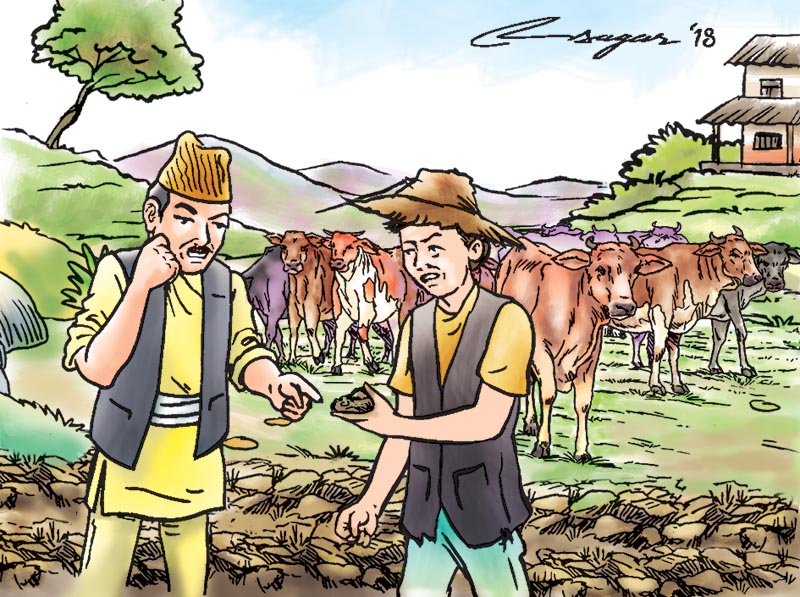Losing the land: Soil erosion and degradation
Soil and agro-ecosystems are essential for sustainable production, hence farmers, social workers, politicians and agriculturists should come together to develop soil management strategies for sustainable production
According to a United Nations-backed study, a third of the planet’s land is severely degraded and fertile soil is being lost at the rate of 24 billion tonnes a year. In Nepal, the situation is even worse because two-thirds of the country’s total area is geologically fragile where soil erosion is exceedingly high. Topsoil loss has been reported as high as 87 tonnes per hectare per year on sloping terraces. When the top soil is lost, the land is degraded.
Poor land management in Nepal has caused soil erosion each year with impacts not just on food production but also on biodiversity loss, carbon loss and disaster resilience. Forecasts on land in South Asia indicate that countries like Nepal will have to face the greatest challenges if better land regulation and improved farming technologies are not put in place.
When farmland is ploughed and tilled, the exposed topsoil is often blown away by wind or washed away by rain. Erosion due to faulty practices in crop production, for example, has resulted in the loss of millions of tonnes of topsoil every year. This leads to reduced soil fertility and degraded land.
Unscientific farming in the hills (steep slope) is one of the causes of soil erosion in Nepal. Shifting cultivation and unnecessary tillage practices also lead to land degradation and damage the ground vegetation and natural ecosystems. Cultivation on the steep slope without taking improved farming practices such as terracing, selection of appropriate crops and use of organic manures into consideration have contributed to increased soil erosion. Furthermore, agricultural intensification produces certain by-products and side effects that are unfriendly to the environment. Ways must, therefore, be found to minimise the effects of these by-products and side effects on the quality of soil.
Maintenance and enhancement of soil fertility are vital for food security and environmental sustainability. Ecologically sound agroforestry systems such as inter-cropping and growing tree crops in the sloppy lands can be helpful for the sustainability of farming. Many farming practices have been developed to improve efficiency in the use of resources and strengthen research on sustainable agriculture in developed countries and have made us hopeful about scientific and technological innovation in the management of soil.
The practice of tilling sloped land along lines of consistent elevation in order to conserve rainwater and to reduce soil losses from surface erosion is called contour farming. It acts as reservoirs to catch and retain rainwater, thus permitting increased infiltration and more uniform distribution of water. The contour farming is a traditional practice in the hilly areas of Nepal.
Another good practice to control soil erosion is the creation of windbreakers by planting evergreen trees around farmland in windy areas like Mustang. It helps prevent the wind blowing away the soil from the farmland. Windbreakers also help in protecting crops from damage caused by strong and severe wind and improve plant health, quality and yield. Crops protected from wind are able to retain significantly more moisture. Matting is the process of covering the soil with biodegradable materials that include mulch, straw, coconut fibre and wood chips. These are held together with biodegradable netting made from coco coir.
Crop rotation with non-hosts of the pathogens that require control is considered one of the most important cultural factors for reducing overall disease problems of crops as well as minimising soil erosion. Beneficial organisms can be added directly, or the soil environment can be made more favourable for them through use of compost and other organic amendments. Soil pH, calcium level, nitrogen form and the availability of nutrients can all play major roles in soil disease management. Adequate crop nutrition makes crops more tolerant of or resistant to disease.
Trees are often considered to be the universal answer to control soil erosion. Tree roots help prevent landslides on steep slopes and streambank erosion. Horticultural crops, particularly fruit trees, have positive implications for the future development of mountain agriculture in terms of minimising soil erosion, harnessing mountain niches and comparative advantages.
Agro-forestry is a sustainable land use system and practice in which woody perennials (trees, shrubs) are grown with herbaceous annuals (crops, pasture grass). It supports the livelihood of billions of people worldwide and provides a wide range of products such as food, fuel, fibre, fodder and forage for livestock. Even the landless farmers sustain their livelihood with this system.
According to a case study of agro-forestry from the mid-hills of Nepal, it is possible to earn Rs 45,490 per hectare from carbon sequestration per household if a payment scheme is introduced. It prevents the further degradation of the undulated fragile land of hilly areas.
Soils and agro-ecosystems are essential for sustainable production, hence farmers, social workers, politicians and agriculturists should come together to develop soil management strategies for sustainable production. Farmers should try to keep their farmland productive for generations to come.
The soil is life, we must conserve it.
Kaini is former director general of Department of Agriculture






